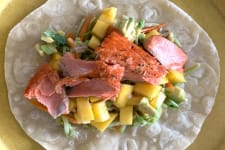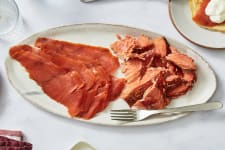
Cod Temperature Guide
November 11th, 2024Why the Internal Temperature for Cod Matters
Cooking Pacific cod to the perfect doneness is key to enjoying its delicate flavor and flaky texture. Knowing the right internal temperature ensures your cod is cooked just right every time. Here, we’ll guide you on how to achieve the optimal internal temperature for cod and how to know when it’s done.
What Is the Internal Temp of Cod When Cooked?
The ideal internal temperature for Pacific cod is between 130F and 135F. This range ensures that the cod is cooked to medium doneness. Doing so provides a balance of firmness and flakiness that highlights the fish’s natural qualities. To get an accurate reading, use an instant-read thermometer and insert it into the fillet. Don’t go for the thinnest part of the fillet or portion. You also want to avoid inserting the thermometer too deep. Instead, shoot for the center in the thickest part of the portion to get an accurate reading.
Reaching 130F and 135F is important, as overcooking can result in tough, dry fillets. Undercooking can leave you with a less-than-desirable texture. Always aim for this sweet spot to enjoy your Pacific cod at its best.
How Do You Know When Cod Is Done?
Aside from checking the internal temperature of cod, certain visual and tactile cues can help you determine when your Pacific cod is done.
-
Firmness: When you press down gently on the fillet with a fork or your finger, it should feel firm but not hard. A properly cooked cod fillet will have a slight give, indicating it is cooked through without being overdone.
-
Flakiness: One of the hallmark signs of perfectly cooked cod is its flakiness. The fillet should easily separate into flakes when prodded with a fork. If the fish resists flaking or feels mushy, it needs more time in the oven or pan.
-
Color: Cooked Pacific cod will turn from a translucent appearance to an opaque white. This color change is a good indicator that the fish is cooked. However, relying solely on color can be misleading, so always cross-check with the internal temperature.
What Should Cod Look Like When Cooked?
When cooked to an internal temperature of 130F to 135F, Pacific cod will have a firm yet flaky texture and a pearly, opaque appearance. The edges may have a slight golden-brown hue if you’re baking or pan-searing the cod, adding to the overall appeal of the dish.
For those who prefer baking their cod, you still want to make sure the baked cod internal temperature reaches the right range. Baking can sometimes cause uneven cooking, especially if the fillet is thick. To avoid this, try to select uniformly thick fillets or adjust cooking times based on the thickness of your fish.
Check out this blog post to see how our recipe team at Wild Alaskan helped a member achieve perfectly cooked Pacific cod.
Note: Consuming raw or undercooked meats, poultry, seafood, shellfish, or eggs may increase your risk of foodborne illness, especially if you have a certain medical condition. The FDA recommends an internal temperature of 145°F for cooked fish.





